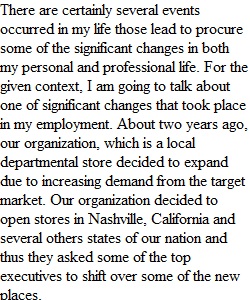


Q 1) Think of a change that you have experience, in either your work or personal life. I would like to ask you to write a story about that experience. Here is a definition of a story to help you. "A story expresses how and why life changes. It begins with a situation in which life is relatively in balance: You come to work day after day, week after week, and everything's fine. You expect it will go on that way. But then there's an event -in screenwriting, we call it the "inciting incident" - that throws life out of balance. You get a new job, or the boss dies of a heart attack, or a big customer customer threatens to leave. The story goes on to describe how, in an effort to restore balance, the protagonist's subjective expectations crash into an uncooperative objective reality". Find similarities to the change stories from Chapter 1 of text. 2) In most organizational change situations there are people who can be categorized into one (or sometime more) of three groups: • Change Strategists who authorize the change (often senior managers) • Change Implementers • Change Recipients How would you define your role in the story from question #1? Most likely, you described a situation in which you were the change recipient. How did you react to the attempted change? What was the most frustrating part of the process? 3) According to Garvin & Roberto in the HBR Article Change Through Persuasion change sticks by following a four-stage persuasion campaign: 1) Prepare your organization's culture "soil" months before setting your turnaround plan in concrete - by convincing employees that you company can survive only through radical change. 2) Present your plan - explaining in detail its purpose and expected impact. 3) After executing the plan, manage employees' emotions by acknowledging the pain of change - while keeping people focused on the hard work ahead 4) As the turnaround starts generating results, re-inforce desired behavioral changes to prevent backsliding. Did the change strategist in your story follow these steps? Which steps? Please explain. (If you used a personal example that is okay, the principles are still relevant) ?
View Related Questions